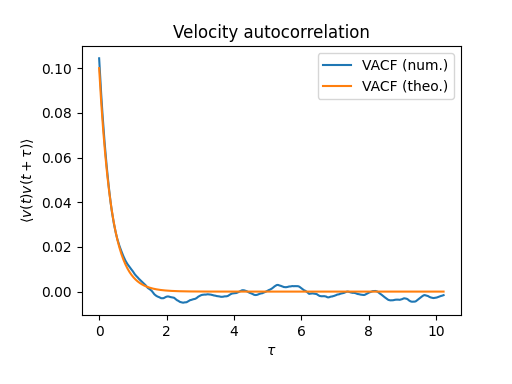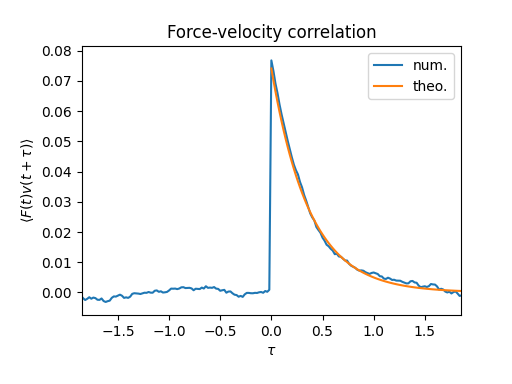Note
Go to the end to download the full example code
Correlation functions¶
Generate the velocity for a Ornstein-Uhlenbeck process and compute its autocorrelation function.
We also display the force velocity correlation as an example of using the routine correlation.
import numpy as np
import tidynamics
import matplotlib.pyplot as plt
plt.rcParams['figure.figsize'] = 5.12, 3.84
plt.rcParams['figure.subplot.bottom'] = 0.18
plt.rcParams['figure.subplot.left'] = 0.16
# Generate data for a Ornstein-Uhlenbeck process
gamma = 2.7
T = 0.1
dt = 0.02
v_factor = np.sqrt(2*T*gamma*dt)
N = 32768
v = 0
for i in range(100):
noise_force = v_factor*np.random.normal()
v = v - gamma*v*dt + noise_force
v_data = []
noise_data = []
for i in range(N):
noise_force = v_factor*np.random.normal()
v = v - gamma*v*dt + noise_force
v_data.append(v)
noise_data.append(noise_force)
v_data = np.array(v_data)
noise_data = np.array(noise_data)/np.sqrt(dt)
# Compute the autocorrelation function and plot the result
acf = tidynamics.acf(v_data)[:N//64]
time = np.arange(N//64)*dt
plt.plot(time, acf, label='VACF (num.)')
plt.plot(time, T*np.exp(-gamma*time), label='VACF (theo.)')
plt.legend()
plt.title('Velocity autocorrelation')
plt.xlabel(r'$\tau$')
plt.ylabel(r'$\langle v(t) v(t+\tau) \rangle$')
# Compute the force velocity correlation and plot the result
plt.figure()
time = np.arange(N)*dt
twotimes = np.concatenate((-time[1:][::-1], time))
plt.plot(twotimes, tidynamics.correlation(noise_data, v_data),
label='num.')
plt.plot(time, 2*T/gamma*np.exp(-gamma*time), label='theo.')
plt.xlim(-5/gamma, 5/gamma)
plt.ylim(-2*T/gamma/10, 1.1*2*T/gamma)
plt.legend()
plt.title('Force-velocity correlation')
plt.xlabel(r'$\tau$')
plt.ylabel(r'$\langle F(t) v(t+\tau) \rangle$')
plt.show()
Total running time of the script: ( 0 minutes 0.373 seconds)

